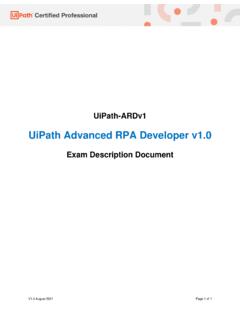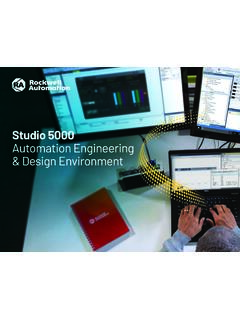Transcription of PISA 2021 Creative Thinking Framework - OECD
1 3 Table of contents Framework for the Assessment of Creative Thinking in PISA 2021: Third Draft .. 5 The case for assessing Creative Thinking .. 5 Why assess Creative Thinking ? .. 5 What is the role of education in Creative Thinking ? .. 6 Evidence-centred design as a general Framework for the PISA 2021 assessment .. 7 Defining the assessment domain .. 8 What is Creative Thinking ? .. 8 Domain generality versus domain specificity .. 9 Domains of Creative engagement .. 9 Confluence approaches of creativity .. 10 Understanding and assessing Creative Thinking in the classroom .. 10 Individual enablers of Creative Thinking .
2 12 Social enablers of Creative Thinking .. 15 Creative engagement .. 17 Implications for the design of the PISA 2021 Creative Thinking assessment .. 18 Focus and objectives of the PISA 2021 assessment of Creative Thinking .. 18 Domains of Creative Thinking included in PISA 2021 .. 18 Competency model of Creative Thinking .. 22 Distribution of tasks, response format and scoring methods in the cognitive test .. 26 Distribution of tasks .. 26 Response types .. 27 Scoring of the tasks .. 28 Example units and scoring methods in the cognitive test .. 31 Unit model in written expression .. 31 Unit model in visual expression .. 33 Unit model in social problem solving.
3 35 Unit model in scientific problem solving .. 37 Design considerations and opportunities for additional indicators based on process data.. 39 Accounting for domain and task-specific knowledge .. 39 Accounting for engagement with the task (task motivation) .. 40 Design features to encourage students exploratory skills and trial and 40 Test development and validation of the cognitive test .. 41 Ensuring appropriate coverage of the construct and cross-cultural validity .. 41 Validation and cross-cultural comparability of the assessment material .. 42 Scaling and reporting proficiency in the cognitive test .. 43 Defining content for the PISA background questionnaires.
4 45 Curiosity and exploration .. 45 Creative self-efficacy .. 45 Beliefs about creativity .. 45 Creative activities in the classroom and school .. 46 Social environment .. 46 References .. 47 Tables Table 1. Possible ways to measure Creative Thinking facets across domains .. 26 Figures Figure 1. Enablers and manifestations of Creative Thinking in the classroom .. 11 Figure 2. Proposed focus domains for the assessment .. 20 Figure 3. Competency model for the PISA test of Creative 23 Figure 4. Examples of tasks in a written expression unit .. 31 Figure 5. Examples of tasks in a visual expression unit .. 33 Figure 6. Example of tasks in a social problem solving unit.
5 35 Figure 7. Example of template for a scientific problem unit .. 37 5 Framework FOR THE ASSESSMENT OF Creative Thinking IN PISA 2021 (THIRD DRAFT) For Official Use Framework for the Assessment of Creative Thinking in PISA 2021: Third Draft The case for assessing Creative Thinking Why assess Creative Thinking ? 1. Creative insights and advances have driven forward human culture across the world in diverse areas (Hennessey and Amabile, 2010[1]): in the sciences, technology, philosophy, the arts and humanities. Creative Thinking is thus more than simply coming up with random ideas. It is a tangible competence, grounded in knowledge and practice, that supports individuals in achieving better outcomes, oftentimes in constrained and challenging environments.
6 Organisations and societies around the world increasingly depend on innovation and knowledge creation to address emerging challenges (OECD, 2010[2]), giving urgency to innovation and Creative Thinking as collective enterprises. 2. While it is true that Creative Thinking drives the types of innovation that have a society-wide impact, it is also a more universal and democratic phenomenon than one might first believe. That is to say that every individual, to a greater or smaller degree, has the potential to think creatively (OECD, 2017[3]). Furthermore, there is a general consensus among psychologists and educators alike that Creative Thinking , understood as engagement in the Thinking processes associated with Creative work, can improve a host of other individual abilities, including metacognitive capacities, inter- and intra-personal and problem-solving skills, as well as promoting identity development, academic achievement, future career success and social engagement (Beghetto, 2010[4]; Plucker, Beghetto and Dow, 2004[5]; Smith and Smith, 2010[6]; Torrance, 1959[7]; National Advisory Committee on Creative and Cultural Education, 1999[8].)
7 Spencer and Lucas, 2018[9]; Long and Plucker, 2015[10]; Barbot, Lubart and Besan on, 2016[11]; Barbot and Heuser, 2017[12]; Gajda, Karwowski and Beghetto, 2017[13]) (Higgins et al., 2005[14]). 3. Developing an international assessment of Creative Thinking can encourage positive changes in education policies and pedagogies. The PISA 2021 Creative Thinking assessment will provide policymakers with valid, reliable and actionable measurement tools that will help them to make evidence-based decisions. The results will also encourage a wider societal debate on both the importance and methods of supporting this crucial competence through education.
8 This work in PISA is connected to another OECD project that aims at supporting new pedagogies that can foster Creative Thinking . For the past years, the OECD s Centre for Educational Research and Innovation (CERI) has been leading an eleven-country study on ways of teaching and assessing Creative and critical Thinking with encouraging early results1. 1 Since 2015 CERI has led an exploration of the teaching and assessment of Creative Thinking in 11 countries Brazil, France, Hungary, India, Netherlands, Russia, Slovak Republic, Spain, Thailand, United Kingdom (Wales), and United States.
9 Taking at its starting point the work piloted by Lucas, Claxton and Spencer (2013[124]) in England, it has prototyped a new teacher-friendly conceptual Framework to think about Creative and critical Thinking in the classrooms in primary and secondary education. It has developed OECD rubrics on Creative and critical Thinking meant to support teachers to develop or improve pedagogical activities that nurture the Creative and critical Thinking skills of their students. An international network of 6 Framework FOR THE ASSESSMENT OF Creative Thinking IN PISA 2021 (THIRD DRAFT) For Official Use What is the role of education in Creative Thinking ?
10 4. A fundamental role of education is to equip students with the competences they need and will need in order to succeed in society. Creative Thinking is a necessary competence for today s young people to develop (Lucas and Spencer, 2017[15]). It can help them adapt to a constantly and rapidly changing world, and one that demands flexible workers equipped with 21st century skills that go beyond core literacy and numeracy. After all, children today will likely be employed in sectors or roles that do not yet exist, using new technologies to solve novel problems. Educating for Creative Thinking can help young people to adapt to develop the capacities to undertake work that cannot easily be replicated by machines and address increasingly complex local and global challenges with out-of-the-box solutions.
















